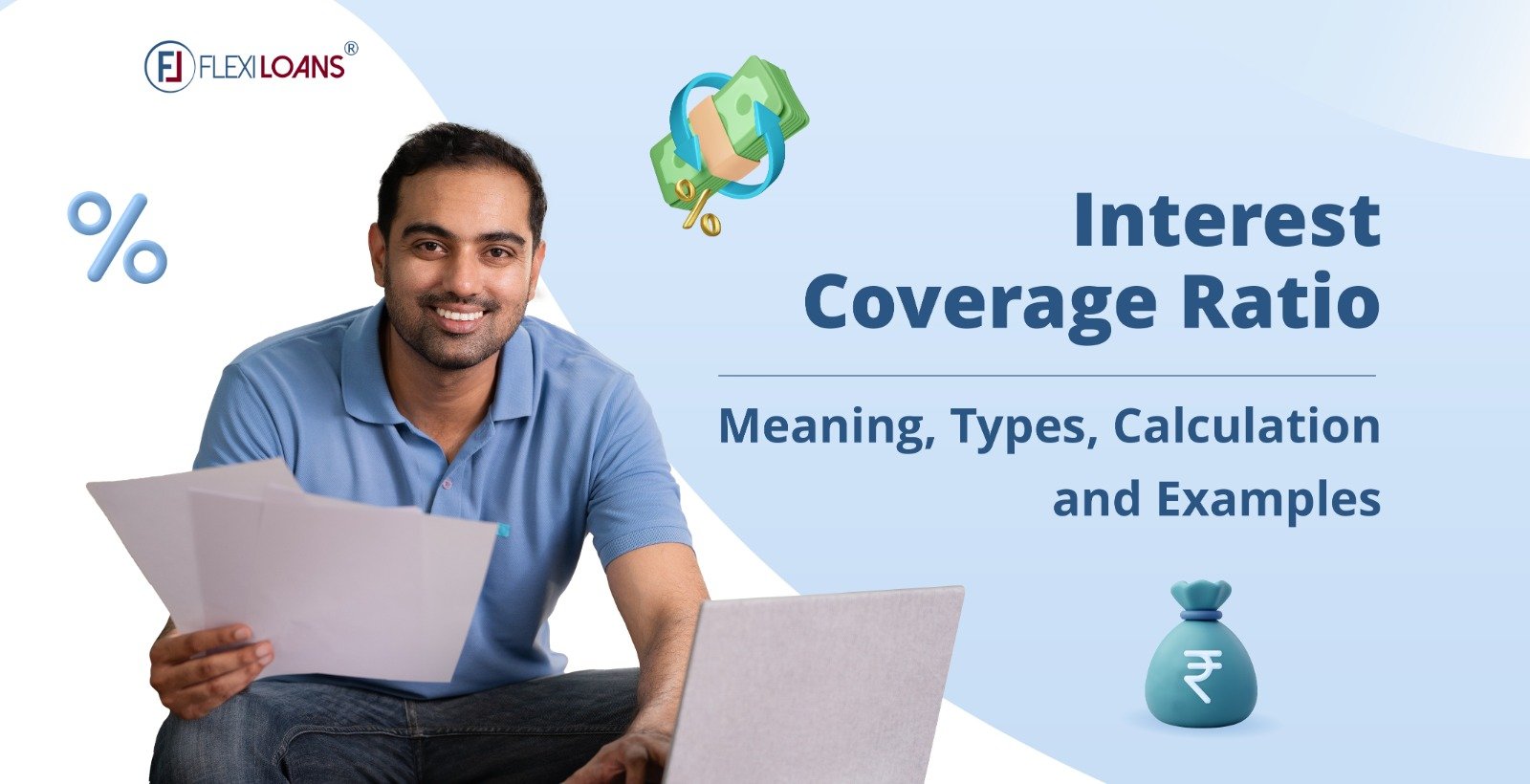Feb 19, 2024
Nov 28, 2025

Introduction
Having access to an affordable line of credit can be vital for any business, allowing them flexibility to cover short-term cash needs. However, too much debt can also put a company at risk if it cannot meet interest payments. This is where the Interest Coverage Ratio comes in – it provides a snapshot of how easily a firm can pay the interest expenses on its outstanding debt obligations.
The Interest Coverage Ratio, also called the Times Interest Earned Ratio, compares earnings before interest and taxes (EBIT) to the interest that needs to be paid on debt, such as lines of credit or loans. It shows investors and creditors how often a company could pay its current interest payment using its available earnings. In this article, we will take a closer look at the Interest Coverage Ratio – So let’s quickly get into it.
What is the Interest Coverage Ratio?
The interest coverage ratio is a solvency measure that indicates the capacity of an organisation to repay its long-term debts and remain free from bankruptcy. It indicates the number of times that the company can pay its loan’s interest with its earnings. For instance, an ICR of 5 indicates that the company’s earnings are five times its interest payments, which means it has an extensive safety margin. ICR of 1 is the scenario in which earnings are equal to the interest payments, suggesting that the company barely manages to repay its debts. An ICR of less than 1 indicates that the company’s earnings are insufficient to cover its loan’s interest charges, implying a high level of default risk for the firm.
Calculation of Interest Coverage Ratio
You can calculate the ICR using a simple method. The formula for ICR is:
ICR = EBIT / The amount of Interest expense
Where:
- The company’s income statement shows EBIT. It is the firm’s profit before subtracting the interest and income taxes.
- The interest expense is the total interest a company owes on any borrowings such as bonds, loans, and lines of credit.
Let us see an example.
Let us assume that the EBIT of company X is ₹ 50 lakh. Its interest expense for the same year is ₹ 10 lakhs. You would calculate the interest coverage ratio as follows:
Get the ratio by dividing 50 lakh of EBIT over interest expense worth 10 lakhs. This yields an ICR of 5.
Types of Interest Coverage Ratios
There are many types of interest coverage ratios, let’s discuss them one byy one in brief.
EBITDA Interest Coverage Ratio
The EBITDA interest coverage ratio simply shows how well a company covers its interest expenses. It shows the company’s core operating profitability, excluding non-cash expenses like depreciation and amortization. The higher the ratio, the more capable the company is of servicing its debt from profits generated through regular business operations.
Fixed Charge Coverage Ratio (FCCR)
FCCR determines the company’s capacity to pay all its short-term financial requisites, such as interest, debt repayments, lease payments, etc. It provides a more comprehensive view than a simple interest coverage ratio. Lenders and creditors regard 1.5 or higher as satisfactory.
EBITDA Less CapEX Interest Coverage Ratio
The ratio measures the number of times EBITDA can cover interest expense after deducting capital expenditure (CapEX). Deducting CapEX, provides a realistic picture of the leftover cash that can be used to pay interest.
EBIAT Interest Coverage Ratio
In this ratio, you use Earnings before Interest after Taxes (EBIAT) in place of EBIT to calculate interest coverage ratio. It offers a clear glimpse of the company’s core operating profitability after taxes. This ratio shows the company’s ability to pay business loan interest from operating income after tax. A higher ratio indicates better debt repaying capacity.
How to Interpret Interest Coverage Ratios?
There is no definitive rule for interpreting interest coverage ratios, as different industries and companies may have different standards and expectations. However, some general guidelines are:
| Interest Coverage Ratios | Interpretation |
| Less than or equal to 1 | The company is at risk of defaulting on its interest payments and may have financial difficulties |
| Between 1.5 and 2 | The company has enough funds to pay its interest and is financially stable |
| Greater than or equal to 2 | The company has more than enough funds to pay its interest and is financially strong. |
Interest Coverage Ratio Example
Here is an example comparing the Interest Coverage Ratios of two companies
Company A
– EBIT: ₹35,00,000
– Interest Expense: ₹7,00,000
Company B
– EBIT: ₹21,00,000
– Interest Expense: ₹4,20,000
Interest Coverage Ratio for Company A = EBIT/Interest Expense
= ₹35,00,000 / ₹7,00,000
= 5 times
Interest Coverage Ratio for Company B = EBIT/Interest Expense
= ₹21,00,000 / ₹4,20,000
= 5 times
Although the absolute EBIT and Interest Expenses figures differ, Company A and Company B have an Interest Coverage Ratio of 5 times. This means both companies have 5 times more EBIT than they require to cover their respective Interest Expenses annually. A higher ratio indicates excellent financial health and the ability to repay loan interest.
So, both Company A and Company B demonstrate adequate coverage of interest expenses from earnings, but Company A has a higher overall EBIT in absolute terms. Their relative ability to repay interest payments is equivalent.
Importance of Interest Coverage Ratio
The interest coverage ratio is integral in shaping key business strategies and decisions. Here are some reasons why the ICR holds such significance:
Assessing Overall Financial Health
The ICR offers an insight of a company’s financial health, especially its capacity to take on and repay debts. A robust ICR indicates a company is generating adequate operating profits to cover its interest expenses comfortably. This signals stability, financial flexibility and a lower risk of default.
Attracting Equity Investors and Creditors
When deciding which companies to invest in or lend to, investors and creditors closely evaluate the interest coverage ratio. A strong ICR conveys lower financial risk and stability, enticing a company to potential equity and debt capital providers. This can increase access to growth financing.
Negotiating Favourable Debt Terms
Companies with higher ICRs typically enjoy more substantial negotiating power to secure favourable loan terms from creditors. Benefits include lower business loan interest rates, higher loan amounts, more extended repayment periods, and greater flexibility on interest payments.
Proactive Risk Monitoring and Mitigation
Regularly tracking ICR enables management to monitor financial risk and stability closely. Declining ICR alerts them to potential cash flow or liquidity pressures. This allows proactive mitigation steps like reducing discretionary expenses, adjusting capital structure, improving working capital cycles or boosting operational efficiency.
Enhancing Financial Credibility
Maintaining a healthy ICR over time builds stakeholders’ confidence and reinforces financial credibility. It signals resilience even during industry or economic downturns. This steady assurance of financial health and debt repayment capacity is vital for securing ongoing investor and creditor support.
Limitations of Interest Coverage Ratio
Using the ICR has many advantages but over-reliance on it can be problematic. Being aware of the following limitations allows a more balanced interpretation:
Sensitivity to EBIT Fluctuations
As ICR relies on earnings before interest and taxes (EBIT), it is sensitive to potential EBIT volatility across fiscal years. This variability in the ratio’s numerator can distort analyses on trends in debt repaying capacity.
Ignores Debt Principal Repayments
The ICR only accounts for interest expenses and ignores principal loan repayments. Meeting principal payments is equally important for highly leveraged firms to avoid default.
Reduced Cross-Sector Comparability
ICRs vary widely across industries based on business models, leverage tendencies and interest rates. This constraints partial comparability for performance benchmarks.
Conclusion
The interest coverage ratio is a financial ratio that measures the ability of a business to pay its interest expenses on its outstanding debt. It is a crucial indicator of financial health and solvency for businesses and investors. You can determine it by dividing the earnings before interest and taxes concerning the interest expense during a given period. A higher interest coverage ratio indicates the business has sufficient earnings to cover its interest payments. A lower interest coverage ratio suggests the business may face difficulty meeting its debt obligations.
To address this potential challenge, businesses with a lower interest coverage ratio may seek additional funds to support their growth, investments, or to navigate through temporary setbacks. That’s where FlexiLoans comes in a leading online lending platform that offers quick online business loan, easy MSME loan to small and medium enterprises, and more.
FAQs
The ICR is a crucial leveraged ratio that allows company management and external stakeholders to assess whether the company generates enough annual operating profits versus its debt costs. A higher ICR generally indicates a better cushion for the company to service their interest payments from earnings comfortably.
While it varies by industry, an ICR of 1.5 or higher is typically considered financially healthy since the company has 50% or more profits than its interest obligations. As a common rule of thumb, an ICR above 3 reflects strong debt servicing capacity.
Some significant factors that influence a company’s interest coverage ratio include operating profit margins, tax rates, interest rates on existing debts, and overall level of debt.
Some common variants analysts assess besides basic ICR are EBITDA coverage ratio, EBIAT (earnings before interest after taxes) coverage ratio and fixed charge coverage ratio. Each provides additional insights on debt servicing ability.
The ICR calculation simply involves taking the EBIT number from the company’s income statement for a given annual fiscal period and dividing it by the total value of reported interest expenses and its debt during that period.
Yes, it is possible for a company reporting operating losses on the income statement to end up with a negative EBIT figure for the fiscal year. This mathematically leads to a negative ICR, signalling high financial risk levels.
A higher ICR is favourable as it indicates that the company’s core operating profits can easily cover annual interest payments on debt with ample room to spare. A lower ICR reflects tighter coverage and, hence, higher risk.
An ICR calculated to be above 1 indicates that the EBIT earnings of the company exceed its interest expense for the year. It signals an adequate cushion for the company to comfortably service and meet debt obligations.
The ratio is extensively used by credit analysts, company management, equity & debt investors and lenders to determine and benchmark debt servicing ability, cash flows and related financial risks before committing capital.
Some constraints involve susceptibility to fluctuating profits year-over-year, accounting distortions of EBIT, and lack of consideration toward repaying unsecured business loan principal amounts and interest expenses.
Yes, it is possible to artificially boost EBIT numbers on the income statement, thereby inflating ICRs by capitalising expenses. But this runs the risk of attracting auditor or regulatory scrutiny.







